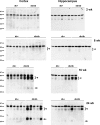Increased tau phosphorylation and cleavage in mouse models of type 1 and type 2 diabetes
- PMID: 19819959
- PMCID: PMC2795717
- DOI: 10.1210/en.2009-0695
Increased tau phosphorylation and cleavage in mouse models of type 1 and type 2 diabetes
Abstract
As the population of the United States ages, the incidence of age-related neurodegenerative and systemic diseases including Alzheimer's disease (AD) and diabetes is increasing rapidly. Multiple studies report that patients with diabetes have a 50-75% increased risk of developing AD compared with age- and gender-matched patients without diabetes. Abnormally phosphorylated tau is a major building block of neurofibrillary tangles, a classic neuropathological characteristic of AD. In addition, proteolytic tau cleavage promotes AD progression due to cleaved tau serving as a nucleation center for the pathological assembly of tau filaments. The current study examines tau modification in type 1 (streptozotocin-injected) and type 2 (db/db) mouse models of diabetes. Tau phosphorylation is increased in the cortex and hippocampus of db/db mice compared with db+ control mouse brain. Interestingly, there is an age-dependent increase in tau cleavage that is not observed in age-matched control db+ animals. Streptozotocin injection also increased tau phosphorylation; however, the increase was less significant compared with the type 2 mouse model, and more importantly, no tau cleavage was detected. Our results suggest tau modification caused by insulin dysfunction and hyperglycemia may contribute to the increased incidence of AD in diabetes. We hypothesize that type 1 and type 2 diabetes may contribute to AD through different mechanisms; in type 2 diabetes, hyperglycemia-mediated tau cleavage may be the key feature, whereas insulin deficiency may be the major contributing factor in type 1 diabetes.
Figures





References
-
- Hebert LE, Scherr PA, Bienias JL, Bennett DA, Evans DA 2003 Alzheimer disease in the US population: prevalence estimates using the 2000 census. Arch Neurol 60:1119–1122 - PubMed
-
- Stevens MJ, Obrosova I, Pop-Busui R, Greene DA, Feldman EL 2002 Pathogenesis of Diabetic Neuorpathy. In: Porte Jr D, Sherwin RS, Baron A, eds. Ellenberg and Rifkin’s diabetes mellitus. Philadelphia: McGraw Hill; 747–770
-
- Brands AM, Biessels GJ, de Haan EH, Kappelle LJ, Kessels RP 2005 The effects of type 1 diabetes on cognitive performance: a meta-analysis. Diabetes Care 28:726–735 - PubMed
-
- Strachan MW, Deary IJ, Ewing FM, Frier BM 1997 Is type II diabetes associated with an increased risk of cognitive dysfunction? A critical review of published studies. Diabetes Care 20:438–445 - PubMed
-
- Ott A, Stolk RP, van Harskamp F, Pols HA, Hofman A, Breteler MM 1999 Diabetes mellitus and the risk of dementia: The Rotterdam Study. Neurology 53:1937–1942 - PubMed
Publication types
MeSH terms
Substances
Grants and funding
LinkOut - more resources
Full Text Sources
Other Literature Sources
Medical
Molecular Biology Databases
Research Materials
Miscellaneous

